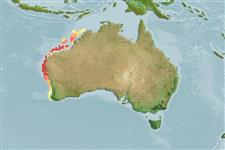Environment: milieu / climate zone / depth range / distribution range
Οικολογία
Θαλασσινό(ά) Υφαλόφιλο(α); εύρος βάθους 57 - 60 m (Ref. 40966). Tropical
Eastern Indian Ocean: Australia.
Μέγεθος / Βάρος / Age
Maturity: Lm ? range ? - ? cm
Found on the continental shelf (Ref. 75154). Mouthbrooders (Ref. 240).
Life cycle and mating behavior
Maturities | Αναπαραγωγή | Spawnings | Egg(s) | Fecundities | Προνύμφες
Employ mouthbrooding to care for their young (Ref. 240).
Shinohara, G., 1999. A new jawfish, Stalix toyoshio, from Kyushu, Japan (Perciformes: Opistognathidae). Ichthyol. Res. 46(3):267-270. (Ref. 35862)
IUCN Red List Status (Ref. 130435)
Threat to humans
Harmless
Human uses
Εργαλεία
Special reports
Download XML
Διαδικτυακές πηγές
Estimates based on models
Preferred temperature (Ref.
123201): 15.9 - 26.4, mean 17.9 °C (based on 9 cells).
Phylogenetic diversity index (Ref.
82804): PD
50 = 0.5005 [Uniqueness, from 0.5 = low to 2.0 = high].
Bayesian length-weight: a=0.00389 (0.00180 - 0.00842), b=3.12 (2.94 - 3.30), in cm total length, based on all LWR estimates for this body shape (Ref.
93245).
Τροφικό Επίπεδο (Ref.
69278): 3.3 ±0.5 se; based on size and trophs of closest relatives
Fishing Vulnerability (Ref.
59153): Low vulnerability (10 of 100).
